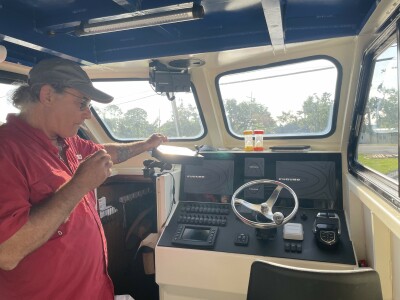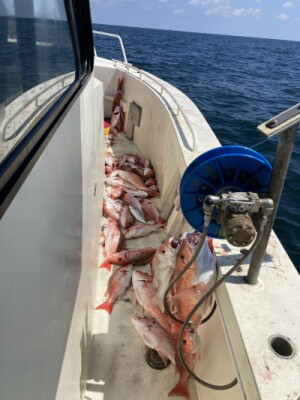A trio of 300-hp OXE diesel outboards is driving one red snapper fisherman’s profitability.
It’s June on the coast of Louisiana, the temperature never drops below 80 and rises fast with the sun, but it’s not too bad in the shade of the shelter roof on James Bruce’s 41-foot aluminum hull, grouper, and snapper boat. “The roof is blue for a reason,” Bruce says, pointing up. “So, when the heat reflects off this white deck, it doesn’t reflect back down on you.”
At 57, having fished most of his life – with the exception of six or seven years on tugs – Bruce has the distinction of being the first U.S. commercial fisherman to power his vessel with OXE diesel outboards. “I don’t know if I’m the only one,” he says, a half-smoked Marlboro held in his teeth. “But I know I’m the only one with three.”
Bruce, gray and grizzled, wearing a faded ball cap with a colorless image of an American flag, points to the three big black outboards lined up on the boat’s extended transom. “I started with three 200s. But it wasn’t enough power. I’m happy with these 300s. I only run them at 70 percent, because I want them to last. We go about 20 knots, a little more on the way out when I don’t have a load on.”

Originally built by Gravois in 2006 as a 38-footer with an 11-foot, 8-inch beam, and 3-foot draft, Bruce extended the transom of his boat another 3 feet to accommodate the outboards. “It don’t have a name on it,” says Bruce. “But we call her the Gray Ghost.”
Today the Gray Ghost sits on a trailer on the parking lot of Outcast Marine in Des Allemands, Louisiana. Getting his vessel to where he wants it has been a 4-year process for Bruce. “I had a lot of problems with the rigging,” he says. “I had trouble with the wiring, and for some reason, I was getting water in the turbo intake hose.” According to Bruce, the original OXE turbos drew air from behind the engine. “They we set it up to pull air from inside the hull, so we don’t get any more water in the engine. This fellow was a diesel mechanic,” says Bruce, nodding towards the Outcast building. “He knows what he’s doing with these, and we they’re running good now. I think they’ll last the rest of my life.”
The Swedish-designed 300-hp OXE outboard uses a horizontal GM or BMW diesel engine with belts that transfer power to the vertical drive shaft. Now being built in Albany, Georgia, the OXE outboards on Bruce’s boat have BMW engines, and while he’s happy with them, he’s still fine-tuning the setup. “We’re putting on new trim tabs,” he says. “I need to get the bow down.”
Besides the three 900-pound outboards, Bruce has a 3,000-pound capacity refrigerated fish hold located in the middle of the work deck about 10 feet forward of the transom. In the lazarette between the fish hold and the motors, he has his electric-driven hydraulic pumps and the condenser, and other components of his refrigeration system. “I’m going to move all this forward,” Bruce says. “Right now, I have a 70-gallon water tank and a 2,000-pound hold up there, but it’s not enough.” The narrow wheelhouse sits about halfway forward from the transom. A hatch in the wheelhouse floor provides access to a 9kW Northern Lights generator and the compressor for the fish hold refrigeration.

The genset runs all the vessel’s electronics and electric systems, including a 2-hp hydraulic pump for the 4 Waterman Industries bandit reels, the 2-hp chiller for the RSW, an 18,000 btu air conditioner, and the Optimus electric power steering. “I just have the regular wheel,” says Bruce. “But you can get it with joystick control.”
The rest of Bruce’s wheelhouse electronics are all Furuno. “I’ve got the Navnet TZ Touch 3,” says Bruce. His suite also includes a Furuno model 1835 radar with a 36-mile radius. He has a Furuno DDF-3D sounder to help him locate his favorite target species, red snapper. “It’s got chirp, single bean, multi-beam, and sides can,” Bruce says of his sounder. “The thru-hull Airmar transducer cost over $5,000. Bruce has also gone with Furuno for his VHF, and Furuno linked autopilot and satellite compass.

Regarding crew comfort, Bruce’s vessel offers virtually nothing. A shower head pokes out from the aft bulkhead of the wheelhouse. Bruce glances at it as if he just noticed it. “We don’t use it much.” The fo’c’sle has just one bunk. “The crew lives nearby,” says Bruce, who resides in Magnolia, Miss. “And when we’re fishing, we barely have time for a sandwich,” Bruce says.
When fishing, Bruce runs his vessel out of Dulac, La., and starts fishing about 30 or 40 miles out in waters at least 130 feet deep. “Any shallower, the fish start getting too small,” he says. Using four hydraulic bandit reels, each with 150 hooks baited with squid or mackerel, he and his two-person crew start making drops.

A pair of 3-minute hourglasses sit on the wheelhouse console. “That’s how long they stay down,” says Bruce. The lines come back up thick with fish. “We average ¾ of a pound per hook. Once we get them up, we start working the fish, we gut’m and get’m into the tanks.” Bruce notes that the fish usually come too fast for the chillers to get them down to temperature as fast as he would like. “We bring three big blocks of ice that we put in there at first,” he says.
“It takes about 24 hours dock to dock to go out and come back with 5,000 pounds,” says Bruce, noting that a factor that makes his business viable is owning his quota. “I own 1 percent of the total commercial allocation,” says Bruce. “This year that’s about 83,000 pounds.”
At $6.50 a pound, the math speaks for itself and validates Bruce’s decision to put somewhere close to $200,000 worth of outboard power on the stern of a small vessel. “It’s a good living,” he says. “The thing is, I’d like to see about 80 more boats like mine out there.”

Changes in quota ownership present the biggest problem in the fishery, according to Bruce, making it difficult if not impossible for new entrants to earn a living.
“I started fishing red snapper in 2002,” he says. “In 2008, EDF (Environmental Defense Fund) took us up to British Columbia to learn about quota management. I voted for it. It works. But what’s going on now is not what I voted for.” Bruce understood at the time that quota would be allocated to individual permit holders and that could not be changed. “But they changed it so that quota is assigned to vessels.”
As Bruce sees it, this change has enabled a handful of players to own and control by other means, percentages of the red snapper resource in excess of the 6 percent limit currently in place. That control has led some new entrants, like Casey Streeter of Matlacha, Fla., to accuse the big quota holders of refusing to lease quota to him because he is advocating for changes in the quota program.
“I think changes are coming,” says Bruce. “At the least, I think we’re going to get a use-it-or-lose-it rule, so that if you don’t catch your fish, they go back into a pool.” Bruce wants to see fishermen holding quota, not speculators. “They’re calling it the adapted catch share program,” says Bruce. “There are people from NOAA fisheries coming to the meetings, and I noticed all the big quota owners and their representatives have been quiet. I think it’s going to go through.”







